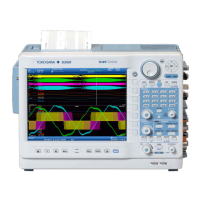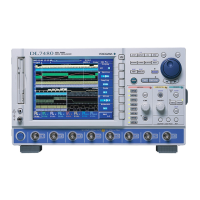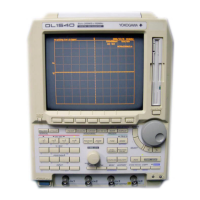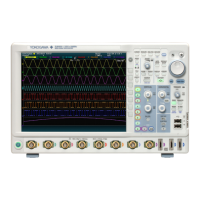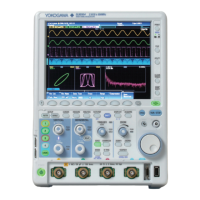2-16
IM DLM6054-01EN
section 7.1 for the procedure
Ordinarily, converted digital data from the 8-bit A/D converter is processed using the selected method,
and stored in the acquisition memory as 8-bit data.
Setting a bandwidth limit on an analog signal reduces data quantization noise and enables the
DL6000/DLM6000 to handle high resolution data that is greater than 8 bits. This increases the practical
resolution of the A/D converter.
In high resolution mode, the process described above is used and the DL6000/DLM6000 saves data
using 16 bits (up to 12 effective bits).
section 7.1 for the procedure
When you turn Interleave mode on, the number of usable channels decreases, but you can set the
sample rate to 5 GS/s in real-time sampling mode (2.5 GS/s in high resolution mode).
When you set the sample rate to 5 GS/s (2.5 GS/s in high resolution mode), CH2 and CH4
automatically become unusable.
* This sample rate applies to the DL6054, DL6104, DLM6054, a
nd DLM6104. On the DL6154, the
sample rate is 10 GS/s (5 GS/s in high resolution mode).
section 7.1 for the procedure
The record length is the number of data points that can be stored into the acquisition memory per
channel. You can set the record length to 2.5 kpoints (2500 points), 6.25 kpoints, 12.5 kpoints, 25
kpoints, 62.5 kpoints, 125 kpoints, 250 kpoints, 625 kpoints, 1.25 Mpoints, 2.5 Mpoints, or 6.25
Mpoints (the maximum record length varies depending on the model).
Ordinarily, when you adjust the time axis settings, the sample rate is automatically adjusted to match
the set record length. When this happens, the specified record length is the same as the display record
length.
Depending on conditions such as the combination of the time axis setting and the sampling mode, the
record length (the display record length) may change. When this happens, the amount of data that
corresponds to the display record length, not to the specified record length, is saved in the acquisition
memory.
section 7.1 for the procedure
The DL6000/DLM6000 samples data using a 2.5 GS/s A/D converter, so the maximum sample rate in
normal sampling mode (real-time sampling mode) is 2.5 GS/s.
*
If you decrease the time axis setting when measuring fast phenomena, the sample rate will reach its
maximum rate (2.5 GS/s) at a certain point.
*
If you decrease the time axis setting further, the number of
displayed points and the display record length decrease.
The DL6000/DLM6000 has two modes for interpolating missing data between data points. Select one
of the interpolation modes when you want to make measurements by setting a sample rate that is
higher than the real-time sampling mode’s maximum sample rate (2.5 GS/s).
*
• Interpolation mode:
The DL6000/DLM6000 interpolates between data points using the (sinx)/x function. This mode is
effective for single-shot signals.
• Repetitive sampling mode:
The DL6000/DLM6000 interpolates through random sampling. This
mode is effective for repeating signals.
* This sample rate applies to the DL6054, DL6104, DLM6054, a
nd DLM6104. On the DL6154, the
sample rate is 5 GS/s.
Relationship between the Time Axis Setting, Record Length, and Sample Rate
The relationship between the time axis setting, record length, and sample rate is as follows:
When the record length (display record length) and the time axis are set so that the sample rate is
at the maximum rate, if you decrease the time axis setting further, the record length (display record
length) is reduced.
Sample rate = Display record length/(time axis setting [s/division] × 10 [divisions])
2.5 Acquisition Conditions

